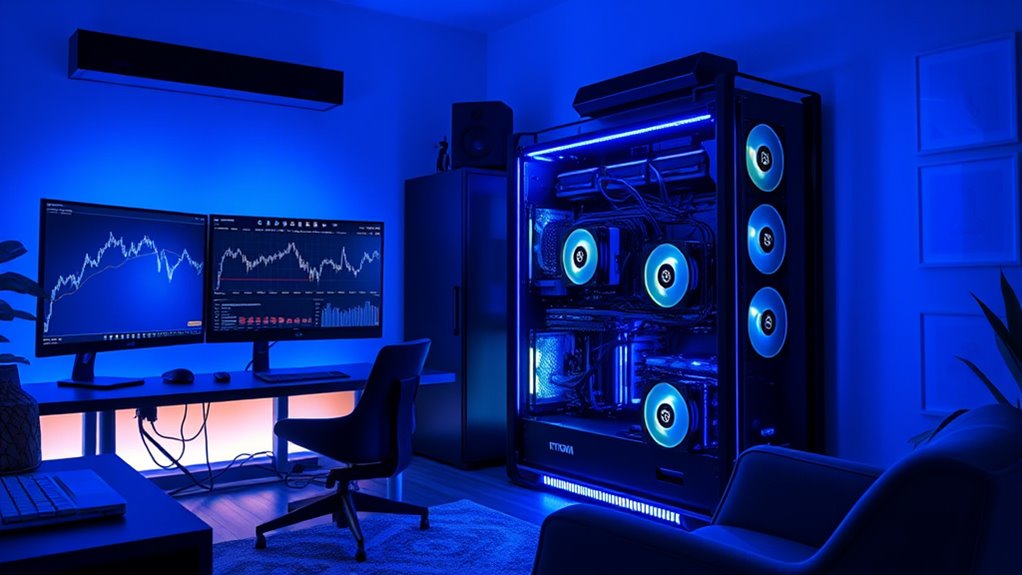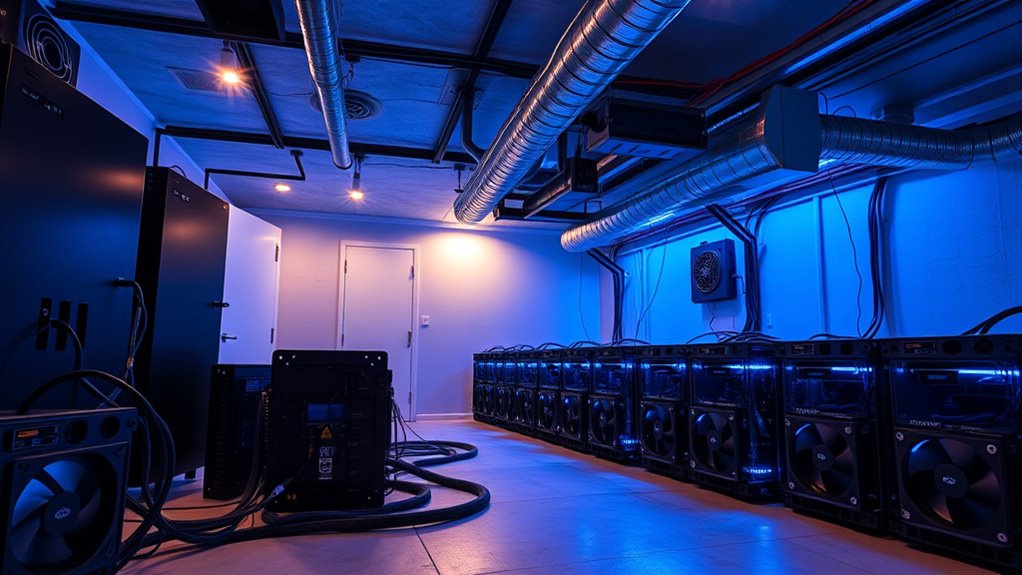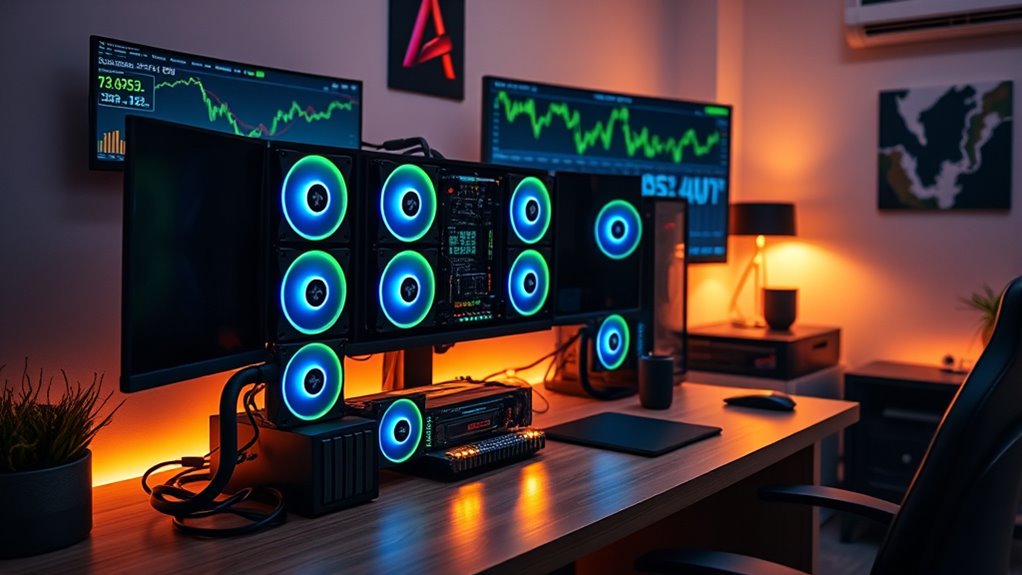Starting Bitcoin mining at home in 2025 is still possible, but you need to be strategic. Rising network difficulty, high electricity costs, and hardware obsolescence make it challenging to stay profitable without efficient equipment and low-cost electricity. Proper cooling, ventilation, and hardware upgrades are essential to maximize gains. If you want to learn how to navigate these challenges, explore methods to optimize your setup and improve your chances of success.
Key Takeaways
- Evaluate electricity costs and cooling solutions to ensure home mining remains profitable amid rising difficulty.
- Invest in energy-efficient ASIC miners with high hash rates and low power consumption for better margins.
- Consider regional electricity rates and potential upgrades to optimize profitability in 2025.
- Stay informed on hardware advancements and implement firmware updates or overclocking cautiously.
- Explore diversification into altcoins or alternative mining setups if Bitcoin mining becomes less viable.
Assessing the Current Feasibility of Home Mining in 2025

Evaluating the feasibility of home Bitcoin mining in 2025 requires considering recent technological, economic, and network factors. You need to recognize that Bitcoin’s increasing network difficulty and rising electricity costs can markedly impact profit margins. While more efficient mining hardware is available, the initial investment remains high, and hardware obsolescence is a concern. Electricity prices are critical; if your rates aren’t competitive, mining may not be worthwhile. Additionally, the noise, heat, and maintenance demands can make home mining less practical unless you have proper cooling and soundproofing. The current market volatility and regulatory environment also influence long-term profitability. Overall, unless you have access to cheap electricity and suitable infrastructure, home mining in 2025 might not be financially viable for casual miners. Proper cooling and soundproofing are essential for managing equipment heat and noise in a home setup.
Choosing the Right Hardware for Home-Based Bitcoin Mining

Selecting the right hardware is essential for successful home Bitcoin mining because it directly impacts your profitability, efficiency, and operational costs. You should look for ASIC miners with high hash rates and low power consumption to maximize your earnings while minimizing electricity expenses. Popular models include those from Canaan Avalon and Bitaxe, which balance noise levels and heat output suitable for home environments. Consider firmware updates and overclocking carefully to boost performance without risking hardware damage. Your choice of hardware also depends on your budget—some machines cost a few hundred dollars, while top-tier models can exceed $10,000. Prioritize efficiency and reliability, and stay informed about new releases that offer better performance and lower energy use to keep your mining profitable in 2025. Additionally, understanding the types of hardware available can help you choose the most suitable equipment for your setup.
Managing Costs and Maximizing Efficiency With Power and Cooling

Managing your costs effectively and boosting efficiency hinges on optimizing power consumption and cooling solutions. Start by selecting energy-efficient hardware with high hash rates and low power draw to reduce electricity expenses. Use power management tools and firmware updates to fine-tune your rigs, ensuring they operate at peak efficiency without overheating. Proper cooling is essential; liquid or immersion cooling can drastically lower heat output and extend hardware lifespan. Ensure your setup has adequate ventilation and consider soundproofing to minimize noise. Monitor your electricity rates regularly, and if possible, shift operations to regions with cheaper power. Additionally, consulting whole-house water filtration systems can help prevent water damage and reduce maintenance downtime, contributing to overall operational stability. Implementing these strategies helps lower operational costs and maintain stable, reliable mining performance, maximizing your profitability in the long run.
Navigating Risks and Challenges of Home Mining Operations

Home mining offers a promising way to earn Bitcoin, but it also comes with significant risks and challenges that you need to carefully navigate. Heat and noise are major concerns—you’ll need proper ventilation and soundproofing to keep your space livable. Internet stability is critical; any downtime can lead to lost earnings or stale blocks, reducing your profitability. Rising network difficulty means your chances of earning rewards decline over time, requiring ongoing hardware upgrades or diversification. Additionally, electricity costs can spike unexpectedly, impacting your margins, and regulatory changes could restrict or complicate your operations. Staying informed and prepared helps you manage these risks better. Proper planning, efficient cooling, and keeping an eye on market shifts are essential to minimize setbacks and protect your investment. Incorporating proper ventilation and noise control measures can also extend the lifespan of your mining hardware and improve your overall setup.
Strategies to Enhance Profitability and Stay Competitive

To stay ahead in the competitive landscape of Bitcoin mining in 2025, you need to focus on optimizing your hardware and operational strategies. Invest in the latest efficient ASIC miners with high hash rates and low power consumption to maximize profitability. Use advanced cooling methods, like liquid or immersion cooling, to reduce heat and extend hardware lifespan. Regularly update firmware and consider overclocking carefully to boost performance without risking damage. Monitor electricity costs diligently and explore regions with cheaper rates or variable pricing to cut expenses. Keep an eye on network difficulty and Bitcoin prices, adjusting your mining setup accordingly. Diversify by mining altcoins with CPU or GPU rigs if Bitcoin mining becomes less viable. Staying adaptable and investing in efficiency are key to staying competitive in 2025. Additionally, researching best beaches and popular beach destinations can provide relaxing breaks from intensive mining activities.
Frequently Asked Questions
What Are the Best Regions for Low-Cost Electricity for Home Mining?
You should focus on regions with abundant, cheap renewable energy, like Iceland, Paraguay, and parts of Iran or Venezuela. These areas offer markedly lower electricity rates, helping you maximize your mining profits. Look for places with stable power grids and supportive regulations. By operating in these regions, you reduce your electricity costs, boost profitability, and lessen environmental impact, making home mining more viable and sustainable.
How Often Should I Upgrade My Mining Hardware in 2025?
You should upgrade your mining hardware roughly every 1 to 2 years to stay competitive in 2025. As technology advances, newer models offer higher hash rates and better energy efficiency, which improves profitability. Keep an eye on industry developments, firmware updates, and hardware obsolescence. Regular upgrades help you maximize mining efficiency, reduce operational costs, and adapt to increasing network difficulty, ensuring you make the most of your investment.
Is It Profitable to Mine Altcoins Alongside Bitcoin at Home?
Is it worth mining altcoins alongside Bitcoin at home? Absolutely, if you have the right hardware and low electricity costs. Mining altcoins can diversify your income and increase your chances of earning rewards, especially when Bitcoin’s difficulty is high. However, it requires balancing your setup’s efficiency and managing multiple coins’ market volatility. With proper management, diversifying your mining portfolio can boost your overall profitability and reduce risks.
What Legal Regulations Should I Consider Before Starting Home Mining?
Before starting home mining, you should check local laws and regulations, as they vary widely. Some areas require permits or have restrictions on electrical usage and noise levels. You might also face restrictions on operating certain equipment or mining cryptocurrencies. Failing to comply can lead to fines or legal issues. So, research your local jurisdiction, consult with authorities if needed, and guarantee your setup adheres to all relevant rules.
How Can I Securely Store and Manage Mined Bitcoin at Home?
To securely store and manage your mined Bitcoin at home, you should use a hardware wallet like Ledger or Trezor. Keep your private keys offline and never share them. Regularly back up your seed phrase in a safe, fireproof location. Use strong, unique passwords for your wallets and enable two-factor authentication. Avoid keeping large amounts on exchanges, and consider cold storage for long-term holdings to protect against theft or hacking.
Conclusion
Deciding whether to plunge into home Bitcoin mining in 2025 demands diligent dedication and daring determination. By balancing bold hardware choices, budgeting wisely for power and cooling, and staying savvy about risks, you can carve out your own profitable path. Don’t let doubts dampen your drive—dare to deploy, innovate, and keep ahead. With focus and fortitude, you’ll find that the fierce world of mining can be both fulfilling and financially fruitful.








